Suiho ... The Gauntlet
Bud Farrell
Ever since September 12th, 1952, I have regarded the Yalu River as a foreboding and forbidden barrier between North Korea and Manchuria, China, and just as "Manchuria" even sounds more sinister than "China", The Yalu will forever hold fearful connotations for me " ... the valley of the shadow of death"! The northwest corridor of The Yalu was like a line describing the very heart of North Korean war industry, and hydroelectric power production for all of North Korea and a major portion of Manchuria ... .The "Ruhr" of the "Hermit Nation"!
In 1952 The Yalu River was a very heavily defended 130 mile GAUNTLET of numerous very heavy antiaircraft artillery gun positions, hundreds of concrete reinforced gun emplacements containing over 300 -85 MM, 88 MM, 90 MM, 105 MM , and up to 120 MM Radar Controlled Guns, manned by well trained RUSSIAN GUN CREWS of the Soviet 10th Antiaircraft Artillery & Searchlight Regiment. There were additionally over 368 very high powered radar controlled searchlights lining several miles of both sides of the River, of which of course, the north side could not be legitimately violated or crossed, thus precluding any attack perpendicular to the river or parallel to the dam across the river, and thus also imposing very severe accuracy restrictions on flight path and drop zone.
Many years after the Korean War, I became aware of S.L.A. ("Slam") Marshall's Book, THE GAUNTLET, about the Korean War and the historic and heroic Chosen Reservoir Marine Corps withdrawal or extraction through overwhelming Chinese Forces in the Fall of 1950, and the breakout to Kotori and eventual pullout from Hungnam on the east coast. It was prior to my knowledge of this book though that I had frequently described the raids on Sinuiju's Oriental Light Metals Works Plant on 7/30/52 , Suiho Hydroelectric Plant 9/12/52, and the Namsan-Ni Chemical Plant raid on 9/30/52, as "running the Gauntlet" ... with virtually the very same bomb run and exposure down the river from east to west, through the same local defenses as well as extremely close proximity to Antung, Manchuria ... the huge dreaded Mig-15 base, estimated to hold 300 Mig -15s , just across the river from Sinuiju, a major city at the mouth of the Yalu and the northwest apex of the triangle known as "MIG ALLEY"! And we made all of our runs from northeast to southwest with great practicality in planning in order to have the SHORTEST distance from target and "Bombs Away", to the relative safety of the Yellow Sea at the mouth of The Yalu in the event of damage requiring bailout or ditching, even when it meant flying the whole width of North Korea and the full length of the "Gauntlet" in order to have a fast escape "bomb out" route!
In effect, several major North Korean targets were within 30 miles and very few minutes of the Mig-15 threat that could NOT be removed, and on some missions we could actually see Migs taking off on well lit runways ... coming up after us with no threat of retaliation to their "hive" or sanctuary! So the combination of escape route, target location on the river, our inability to cross the river, essentially "chanellized" our bomb run to frequently paralleling the river and thus became a known and well established route for us AND their gun batteries and searchlights ... like a well lighted boulevard! The Chinese, North Koreans, and RUSSIANS, had simply to fire at the obligatory course the B- 29s had to fly ... a "box barrage"!
In the early morning of September 12th , there was a buzz in the air that generally reflected something big - a MAX EFFORT - and the nervous edge adrenaline started early with preflighting the ship , loading EXTRA ammo, cleaning and checking guns and rechecking turret systems, pressure checking engines, etc., an all day job. With late afternoon briefing the Group Briefing Room was "wired " with tension ... the curtain drawn ... and the red line went right up to the Yalu ... near Antung ... Manchuria ... .MIG ALLEY! Right ON the river, Suiho Hydroelectric Power Plant, just below the Dam, at the base ... even more complicated and difficult than going after the dam itself! There were whistles and sighs upon just seeing the red line...even before the mission details, and then there were groans and a few heaves ... some got physically sick in the back of the room ... big game jitters!
 KOREAN WAR SERVICE MEDAL |
SUIHO - THE RAID
We had been up to Sinuiju on the Yalu a month before on July 30/31, the Oriental Light Metals Works, a large complex previously not hit, just about four miles across the Yalu from Antung, the Mig base, and very heavily defended, and we had gone over without any damage but Suiho was going to be another matter Due to the target location, and preciseness required with the power plant tucked in at the base of the high dam, our approach was down river from the northeast in order to afford the shortest escape route out to over water in the Yellow Sea in the event of an emergency. An attack from any other direction would also have put us across the river into Manchurian Territory since the River took a sharp bend to the southwest right at the dam, with the dam at the apex of an inverted "V" in the river, and even our approach from the northeast paralleling the river required a dramatic "full needle width turn" immediately at "BOMBS AWAY" to preclude our intrusion into China! As we turned off target I remember looking almost STRAIGHT down out of my blister as we made a hard left, and thinking "we're gonna slide off!" ... the sharpest turn I EVER experienced in a B-29!
An early evening takeoff at about 19:30 would put us over Suiho at shortly after midnight and about halfway back in the three group bomber stream, with sixty second separation (approximately 3 miles) between all aircraft at takeoff and throughout the mission, scheduled as a Max Effort, requiring virtually all flyable aircraft to go, up to as many as 60 ships, twenty from each Group. Takeoff and the trip enroute were routine until we got near the 38th Parallel, demarcating the Koreas and the Front lines, at which time in our climb through an unpredicted weather front to bombing altitude, we started to pick up ice on the control surfaces which our Aircraft Commander felt in the sloppiness of the ship, and he requested increases in power by the Flight Engineer several times to shake ice and prevent a stall.
After several tense minutes we got through and above the front but heard on VHF radio, a 93rd Squadron Sister ship, Major Sander's, crew in some distress from icing and only later learned that they had not been able to shake the ice and had augured in from approximately 25,000 feet with their full bomb load, with only one out of twelve surviving a last second bailout at 500 feet.
After the anxiety of hearing the breaking ice ricocheting off leading edges of our control surfaces, with no apparent damage and a clean ship again, we continued for another 200 miles to the I.P. ( Initial Point) for our run in on the target ... through much clearer than predicted skies. As we approached the I.P. from the southeast and before our turn to the left on the bomb run, I could see hundreds of antiaircraft gun flashes, both on the ground and the resultant flak bursts in the air at our altitude and above, and many fingers of searchlights stabbing at the aircraft ahead of us, almost a boulevard of beams lined up along the path. The "Box Barrage" of flak was described by one old pro, Capt. Frank Roll, as being as good as the Germans had put up over Berlin ... and which had brought him down and made him a POW in WW II!
As we turned on our heading to the target, with no diversion or evasive deviation in our track allowed, our A.C. (Aircraft Commander) called on interphone and said "Hang onto your ass ... they're catching hell up in front of us" ... and I felt an exhilaration and adrenaline flow like we were goin'over the top on an amusement park wild roller coaster ride ... with breath held and sweating fists clutching the cold metal frame of the blister for some feeling of solidarity ... the only time I had the heavy canvas covered lead stripped flak jackets under AND on me! Enemy aircraft were dropping brilliant orange and white parachute flares above the bomber stream to illuminate the B-29's to the orbiting Migs waiting to pounce, with some so intent in pressing their attack that they pursued the B-29's right into their own flak. I remember hunkering down behind my gun sight and trying to retreat within my oversized flak helmet like a turtle withdrawing its head into its shell ... and from somewhere very deep within the recesses of my memory of having had to go to The Transfiguration Catholic Church in West Philadelphia with Cousins and Aunts just a few times, came the words "Holy Mary Mother of God Pray for us sinners now and at the hour of our death ... and "Now I lay me down to sleep. . .!" MORE THAN TWICE!
From that point at the I.P., to the target and "Bombs Away", there were continuous flak bursts around us , perhaps thousands within sight like a very long string of firecrackers going off in your face and all seeming closer in the dark then they really were, searchlights scanning from both sides of the river trying to find and lock on us ... .as they had each aircraft ahead of us ... and then one huge overwhelming flash directly ahead of us reduced all others to nothing ... and a B-29 immediately in front of us no longer existed ... with only burning debris fluttering through the darkness to the hillside ground on the Manchurian side of the river ... and our pilot (copilot) impulsively yelled on interphone "Christ look at that!" The B-29 directly in front of us had taken a direct hit and disintegrated with the explosion of its full bomb load ... and twelve men! This has always remained with me as what "Dante's Inferno" might look like!
As we flew on, I tried to climb inside the flak helmet and make myself even smaller and ducked behind the gun sight reflexively, convulsively, through flashes, searchlights, and the rattle of falling spent flak shrapnel against our ship, and the ONLY time I ever actually smelled cordite from the flak explosions. At some point we took a direct hit of a major round that miraculously did NOT detonate on contact and went through our horizontal stabilizer VERY close in to the fuselage and Tail Gunners compartment, went up alongside the vertical stabilizer, grooving it for about ten feet and perhaps detonated above and behind our ship ... with no effect on our controls or other equipment ... and not discovered until we landed.
| REMEMBER THEN Remember then, fix within your dreaming head, year, hour, or - by Edwin Muir - |
Captain Ralph Walt's crew, just in front of us, was not as lucky, having a major round ricochet off their # 3 engine prop blade and then detonating just above the rear bomb bay and Gunners compartment just after bombs away, wounding two very seriously and damaging the aircraft with loss of electronics, radios, etc. Frank Skarritt, Right Gunner, and Lt. Bill King, Radar Observer, in the rear Gunner's Compartment, were severely wounded and were given blood plasma from the first aid kits they had aboard as they struggled to make it into an emergency base in South Korea. Their Aircraft Commander, Captain Ralph Walt, was awarded the Distinguished Flying Cross for his desperate and gallant successful effort to save his crew and aircraft! This was their 13th mission ... and they were hit after midnite ... September THIRTEENTH! NO one talked about our forthcoming 13th ... like hotels not having a 13th floor!
# 790 Walt Ship at K-13 Suwon AFB, South Korea for battle damage 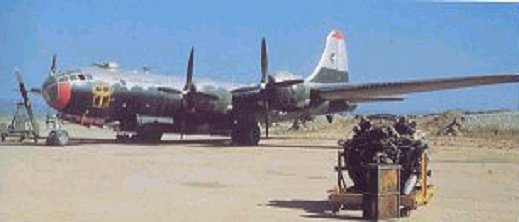 repair after Suiho Mission Sept 12th/13th,1952. # 3 engine replaced. |
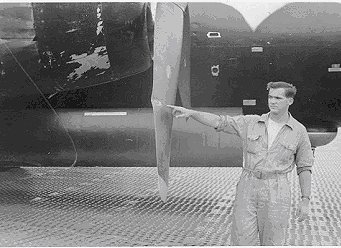 Major AAA round ricocheted off and bent # 3 engine prop blade and detonated above rear bomb bay and gunner's compartment, spraying shrapnel and wounding Right Gunner Frank Skarritt and Spare Radar Observer Bill King as shown in subsequent pictures. Engine had to be shut down due to vibration from flak damage and was replaced at K-13 in South Korea. Frank Eckles returned to Kadena AFB in C-47 with Al Gerato, Flight Engineer and sole bailout survivor of Sanders crew ( and my room mate for 2 weeks). After # 802 "BAIT ME" augered in from icing, with loss of 11. |
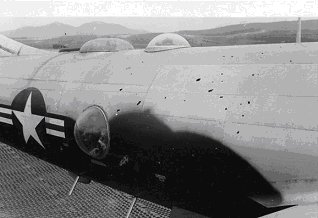 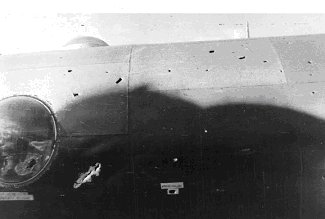 "All in all, not bad ... it made it back ... we'll fix 'er up ... she'll go again!" |
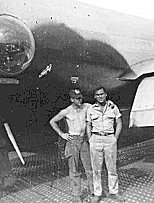 Griggs & Grubbs, # 790 Ground Crew |
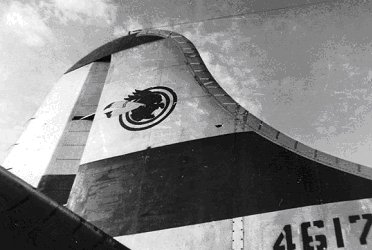 That 93rd Bomb Squadron Indian had a near miss too! |
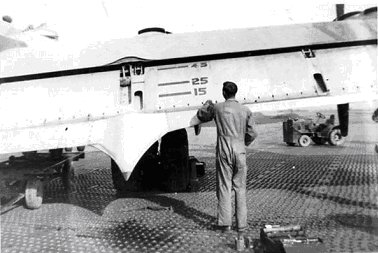 Right Flap full down for inspection for flak damage, # 3 engine and prop removed for replacement. These huge flaps set at 25 degrees gave great lift for heavyweight takeoff when loaded, and even greater lift at 45 degrees for a slower landing. A "flaring" B-29 returning from a combat mission on landing was a beautiful sight ... and an even better feeling! |
Moments after Bombs Away and our sharp near slide -off turn, Captain Cheney called for the usual "Crew Report" and each position member from front to back in that order checked in "Bombardier Ok" ... "Pilot OK" ... " Engineer OK" ... "Navigator here" ... "Radio OK." ... "CFC alright Cap'n" ... "Left Gunner OK" ... "Right Gunner OK Sir" ... "ECM OK ... "Radar OK" ... "TAIL? ... Joe ... Tail Gunner ... report ... Joe, check in!!" "Bud, take a walk-around bottle (oxygen) and go back and check on Joe B. ... and Rex , stay in your position and watch for a signal from Bud if he needs help back there. OK, everyone be alert, we're not outa' the woods here!"
My heart was in my throat ... hands shakin' as I tried to fit the alligator clamp of the walk-around bottle on my chute harness and reconnect my oxygen mask to the fitting ... all thumbs ... and gloves ... Jesus! Struggling past the CFC Barber chair and thru the Radar Compartment Bulkhead door, I was now past the lower aft turret, bumping into everything ... cursing the darkness ... now onto my knees on the two wooden skids laying alongside the tail ammo cans in the pinched empennage back to the tail ... "Goddamnit Joe!" ... now at the bulkhead door to the Tail Compartment.
... "Joe ... ..JOE ... ... HEY JOE!" No response over the noise of the engines reverberating off the uninsulated aluminum skin and frame ... just two legs in sheep- skin lined Flying Boots dangling from the seat above the Bulkhead door, "Shit ... he's hurt" ... and I wondered how the hell I could get him down off the fold up seat and out of there ... impossible to lift him off the seat from underneath ( * ), I made an almost useless and hopeless gesture of grabbing the calf of Joe's leg ... and he damn near went through the overhead of his compartment ... "YEOW"!!!!
He screamed ... and I reacted and hit my head on the bulkhead frame ... "Son of a Bitch!" ... Joe was fine, and his interphone headset connection had apparently snagged on his chute harness and become disconnected as he swiveled his head scanning for fighters, and he never heard the requests for crew check-in. Whew ... back to my position with my heart still racing! At debriefing we roared ... Joe said "goin' along at 25,000 feet in the dark and somethin' grabs ya' by the leg ... whada y'all boys THINK I'd do ... GORAY!" "Goray" was Easley- South Carolinese for "Golly!" In 1985, at our first reunion in 33 years, the first thing Joe B. said on seeing me was ... "GORAY"!
"THEN and NOW"
It was only many years Later that I learned from Darold (Woody) Woodcock, Radio Operator of Walt's crew, that their crew attributed a good deal of their successful return to South Korea , to our crew being the only crew over North Korea that night willing to break radio silence in their behalf to relay their request to an emergency base, K-13 near Suwon, to send up - fire - some green flares if they could hear Walt's aircraft engines. Their crew thought that they could see the blacked-out fighter strip but weren't certain enough to attempt a landing ... and they didn't want ANTI-Aircraft defenses shooting at this stranger approaching. The green flares were a huge relief to the very anxious crew, including two severely wounded, Bill King and Frank Skarritt, and a swell of cheers came forth among the crew now believing they could get on the ground even though they had 4 red lights on the engines and 3 red lights on the landing gear ... .all proven later to have been caused by flak shrapnel cutting off the tubes to the engine oil pressure gauges and the electrical lines to the gear indicators.
Woody says he'll never forget that no one else answered his and their calls for help except Joe- "Tiger"- Whisman, OUR Radio Operator and Woody's Keesler Field, Biloxi, Mississippi, Radio Operator School buddy, who got clearance from our Aircraft Commander Captain Cheney, to relay messages from Captain Walt to K-13 ... and they would have done the same for us as their "sister crew"!
I have also relocated Tom Delsignore of Wrentham, Massachusetts who had replaced Frank Skarritt, Right Gunner on Walt's crew, who was wounded that night of September 12th, 1952 over Suiho (as related on Page 194 in THE SPARE GUNNER in NO SWEAT) and I have now obtained a current 2004 picture of him to add to that story ... his great hearty laugh and "creative imagination" (Quonset Hut "Art") are still the same!
Heroes are people who do what has to be done when it needs to be done,
regardless of the consequences!
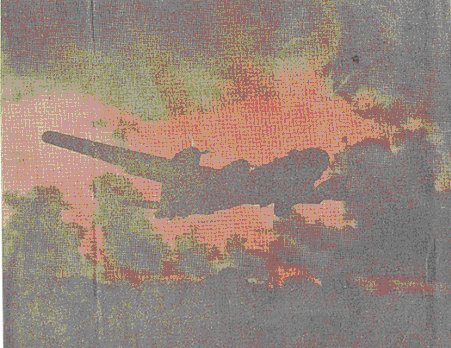 Fire in the sky behind ... fire in the sky ahead! |
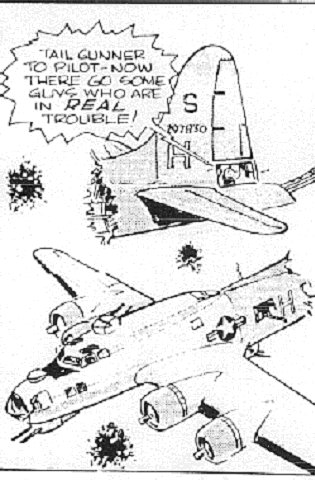 - Cartoon by Bob Stevens/Plane Stuff - Reprinted with special permission of Barbara Stevens |
"Remember ... life is not measured by the number of breaths we take,
but by the moments that take our breath away!"
 Crash remains of a 307th Bomb Wing, 370th Bomb Squadron ship that crashed on mountain 5 miles south of Taegu, South Korea, September 13th, 1952, after the Suiho Raid., one of three B-29s lost the night of Sept. 12/13, 1952. Air Force Magazine Photos |
Our crew was awarded The Air Medal for the Suiho Mission, "for meritorious achievement in Aerial Combat", for this our 10th Mission, nothing else. I treasure the medal for only the memory of that night ... AND that I didn't have to get Joe B. out of that Tail Compartment! |  |
| NIGHT BOMBER By John Hankins R.A.F. Lancashire, England |
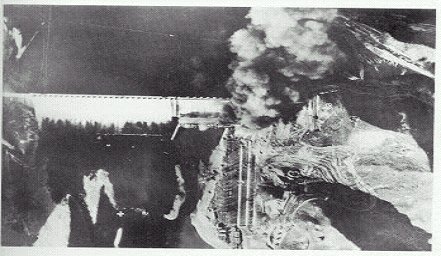 Power Plant and Transformers at base of dam destroyed. (Manchuria, China on left of Yalu River, North Korea on right. Dam is 349 feet high, 2,900 feet wide) |
| * Can you imagine doing this in the dark in a serious emergency? SAC Standard Operating Procedures Manual -September 1951 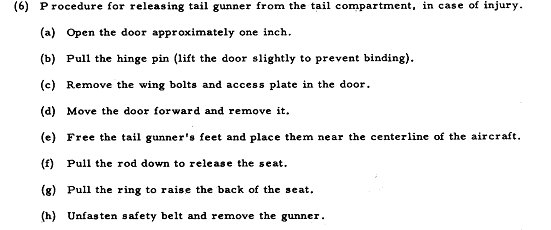 "REMOVE THE GUNNER"? TO WHERE? I had enough trouble crawling back there ALONE without even thinking of trying to drag Joe! Sorry Joe! |
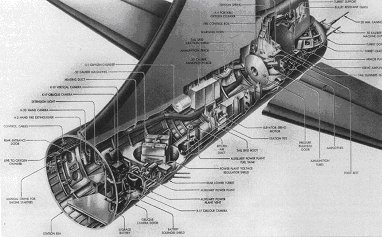 Cutaway diagram of aft unpressurized compartmentand Tail Gunner Compartments and bulkhead door I opened to access Tail compartment and Joe B., a long tight 30 foot plus crawl ( with heavy cold weather clothing and flying gear on, parachute, Mae West, 45 holster, walk-around oxygen bottle and mask, etc) in the noisy and cold darkness from the Gunner's Compartment. Boeing Aircraft Company Diagram |
| "... But the bomber pilots have to be braver than brave to sit there and take it ... just 'drilling on to the target' ... in spite of everything." Joe Foss Marine Corps Ace, Guadalcanal WW II: Medal of Honor |